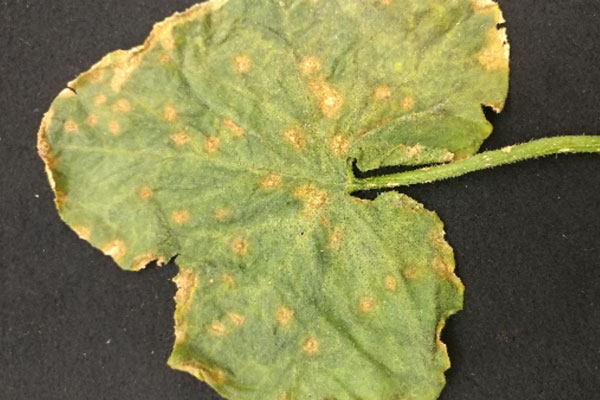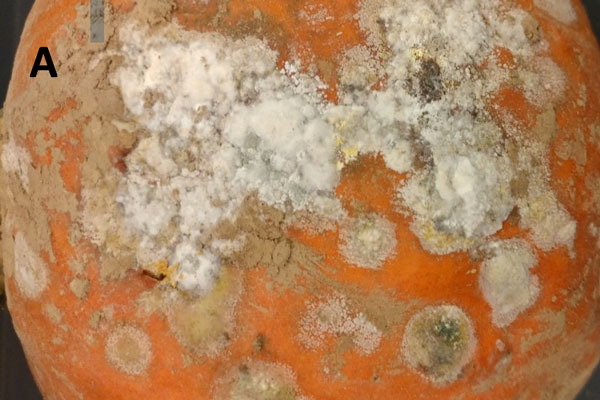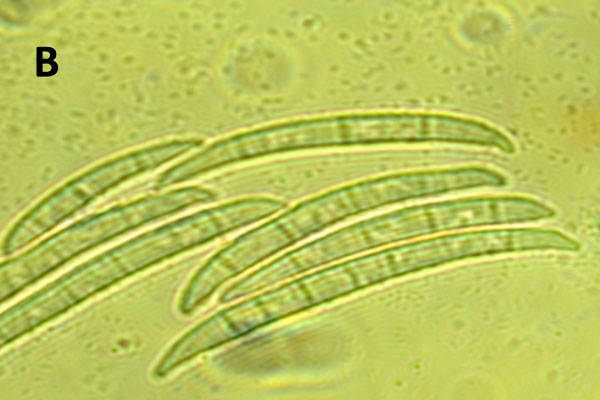Taking an environmentally sensitive approach to pest management
Spotlights: MU Plant Diagnostic Clinic
Published: October 24, 2018
The following are highlights about samples and disease issues diagnosed at the Plant Diagnostic Clinic in the month of September.

Soft rot on cabbage caused by Pectobacterium carotovorum subsp. Carotovorum
Soft rot of cabbage
Soft rot, caused by Pectobacterium carotovorum subsp. carotovorum is a widespread destructive disease of vegetables worldwide. The bacteria infects succulent plant parts such as tubers, fruits, bulbs, corms, rhizomes, buds, petioles and leaf stalk tissues. Soft rot losses can occur during cultivation in the field and after harvest in storage. The bacteria attacks several vegetable crops including cabbage, broccoli, onion, potato, pepper, melon, cucumber, bean, and beet. Symptoms of infection appears as small, water-soaked areas that rapidly enlarge. Affected tissue becomes soft and mushy with foul odor. The affected plant part may decay and collapse within a few days.
The bacteria overwinters in soil and infected debris, and infect plants through wounds caused by frost damage, insect injuries, harvesting and handling. The bacteria is spread by affected plant tissue, irrigation water, rain, insects and infested pruning tools. Soft rot disease development is favored by warm [25-30°C (77-86°F)], humid conditions with prolonged periods of wet weather.
Control of soft rot involves multiple measures. Minimizing wounding during cultivation, harvesting and handling can help to reduce spread in the field or storage. Start plants with disease free seeds and transplants. Select well drained site for planting. Control frequency of irrigation, avoid overhead irrigation and using stagnant water source. Grow resistant crops in rotation with susceptible vegetables. Harvest crops during dry weather condition. Store and ship produce in clean and cool conditions.
Diseases of cucurbits
Anthracnose of Cucumber
Anthracnose is a widely distributed fungal disease of cucurbits. The MU Plant Diagnostic clinic received a sample of cucumber with leaf spots caused by the fungus Colletotrichum orbiculare (syn. Colletotrichum lagenarium). Anthracnose can cause serious losses of cucumbers, melon, watermelon and muskmelon whenever susceptible cultivars are grown but rarely infects pumpkin and squash. Warm, humid, and frequent rain favors disease development and spread. Infection can occur on seedlings, leaves, petioles, stems, and fruits.

Leaf spots on cucumber caused by Colletotrichum orbiculare
Leaf symptoms start as a small water soaked lesion with yellowish appearance. As the disease progresses, the lesion expands and turns into brown spots which may coalesce resulting in leaf blighting. Lesions on the leaf petiole and stem are shallow, elongate and tan. Severe infection of the petiole, stem, fruit and pedicel can cause extensive defoliation, lower fruit quality and yield loss. The fungus survives between crops on seeds, volunteer weeds and on infected crop residues. Spread of the fungus occurs by splashing rain, overhead irrigation, insects, field workers and tools.
Effective management of anthracnose disease involves an integrated pest management strategy. Start with certified clean seeds to reduce disease incidence on the field. When purchasing transplant seedling, carefully inspect plants for disease symptoms before transplanting. Scout plants regularly for signs of disease. Control volunteer cucurbit weeds and alternate host around the field. Plow down deeply all infected debris immediately after harvest. Practice crop rotation for at least two years with crops other than cucurbits. Regular fungicide application as soon as disease is detected can help to reduce disease severity. Information on chemicals registered for anthracnose disease on cucurbits is available in the Midwest Vegetable Production Guide for Commercial Growers.


Fusarium fruit rot caused by Fusarium species. A Pumpkin fruit with lesion, B macroconidia of Fusarium species
Fusarium fruit rot
Fusarium fruit rot, a common pre and post-harvest disease of many cucurbits, can severely affect fruit quality. The disease is more destructive on pumpkin and squash. Fruit rot losses can occur in the field or in storage after harvest. Several Fusarium species including F. equiseti, F. acuminatum, F. graminearum, F. avenaceum, and F. solani are associated with fruit rot in cucurbits. The pathogen is seed borne and can survive as chlamydospores in the soil for 2-3 years.
Symptoms develop on fruit surfaces in contact with soil as firm, dry, sunken lesions of varying sizes covered with white or gray fungal growth. Disease symptoms can vary with host, plant age, environmental conditions, soil moisture, pathogen population in the soil, and the aggressiveness of the strain.
Effective management of this disease involves an integrated pest management strategy.Plant resistant cultivars, start with disease free seeds and do not save seeds from the infected fruit. Practice rotation with non-cucurbits for 4 years. Avoid planting in fields with history of disease. Providing physical barrier between the fruit and the soil can help to minimize the disease and avoid wounding of the fruit during handling.
Subscribe to receive similar articles sent directly to your inbox!
- Top 3 Considerations when Submitting Samples this Season (03/14/22)
- Spotlights: MU Plant Diagnostic Clinic (10/24/18)
- Missouri Disease Beat (08/01/14)
REVISED: February 21, 2017